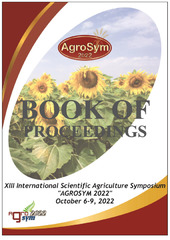Приказ основних података о документу
Antifungal activity of plant essential oils to the Fusarium verticillioides originated from garlic
| dc.creator | Starović, Mira | |
| dc.creator | Ristić, Lela | |
| dc.creator | Vučurović, Ivan | |
| dc.creator | Blagojević, Jovana | |
| dc.creator | Stošić, Stefan | |
| dc.creator | Živković, Svetlana | |
| dc.creator | Aleksic, Goran | |
| dc.date.accessioned | 2023-07-17T09:51:00Z | |
| dc.date.available | 2023-07-17T09:51:00Z | |
| dc.date.issued | 2022 | |
| dc.identifier.isbn | 978-99976-987-3-5 | |
| dc.identifier.uri | https://plantarum.izbis.bg.ac.rs/handle/123456789/787 | |
| dc.description.abstract | Garlic (Allium sativum L.) is the second most cultivated Allium species worldwide. Many viral, fungal and bacterial diseases attack garlic plants and can be a limiting factor to garlic production. Fungal diseases control is mainly conducted by fungicides, which have detrimental impact on the environment. In this work, we explore the possibility of utilizing essential oils (EOs) as antifungal agents against a fungal isolate originated from symptomatic garlic cloves from Kraljevci locality, Srem District, Serbia, morphologically and molecularly identified as Fusarium verticillioides. EOs used in this study originated from several medicinal plants: Turkish pickling herb (Echinophora tenuifolia), oregano (Origanum vulgare), basil (Ocimum basilicum) and myrtle (Myrtus communis). Minimum inhibitory concentrations (MIC) were determined by microdilution method in 96 well microtiter plates. Microtiter plates were incubated for five days at 28°C. The experiment was repeated four times with trifloxystrobin as a positive control. The lowest concentrations without visible growth were defined as the minimal concentrations inhibiting fungal growth. Fungal spores were washed from the surface of potato dextrose agar (PDA) and spore suspension was adjusted to a concentration of approximately 5.0x104 in a final volume of 100μl per well. The values of minimal inhibitory concentration (MIC) were carried out by Duncan’s multiple range tests. An analysis of variance was performed on MIC data for four EOs applied on F. verticillioides. A significance was evaluated at p<0.05. STATISTICA v.7 (StatSoft, Inc.) was used for statistical analyses. The results of the antimicrobial activity of EOs using microdilution method showed a wide range of antifungal activity against F. verticillioides. The basil EO proved to be the most potent one (MIC-0,325±5,10μg/mL), followed by oregano (MIC-0,775±0,05μg/mL), myrtle (MIC-5,5±0,05μg/mL) and Turkish pickling herb (MIC-55±5,10μg/mL). The data obtained here suggest that the selected EOs can be applied as inhibitors to prevent growth of the phytopathogenic fungus F. verticillioides. | sr |
| dc.language.iso | en | sr |
| dc.publisher | University of East Sarajevo | sr |
| dc.relation | info:eu-repo/grantAgreement/MESTD/inst-2020/200010/RS// | sr |
| dc.rights | openAccess | sr |
| dc.rights.uri | https://creativecommons.org/licenses/by/4.0/ | |
| dc.source | Proceedings of the XIII International Scientific Agricultural Symposium “Agrosym October 6-9, 2022 | sr |
| dc.subject | Garlic | sr |
| dc.subject | Essential oil | sr |
| dc.subject | Antagonistic | sr |
| dc.subject | Minimum inhibitory concentration | sr |
| dc.title | Antifungal activity of plant essential oils to the Fusarium verticillioides originated from garlic | sr |
| dc.type | conferenceObject | sr |
| dc.rights.license | BY | sr |
| dc.citation.epage | 650 | |
| dc.citation.issue | 645 | |
| dc.type.version | publishedVersion | sr |
| dc.identifier.fulltext | http://plantarum.izbis.bg.ac.rs/bitstream/id/3017/bitstream_3017.pdf |


